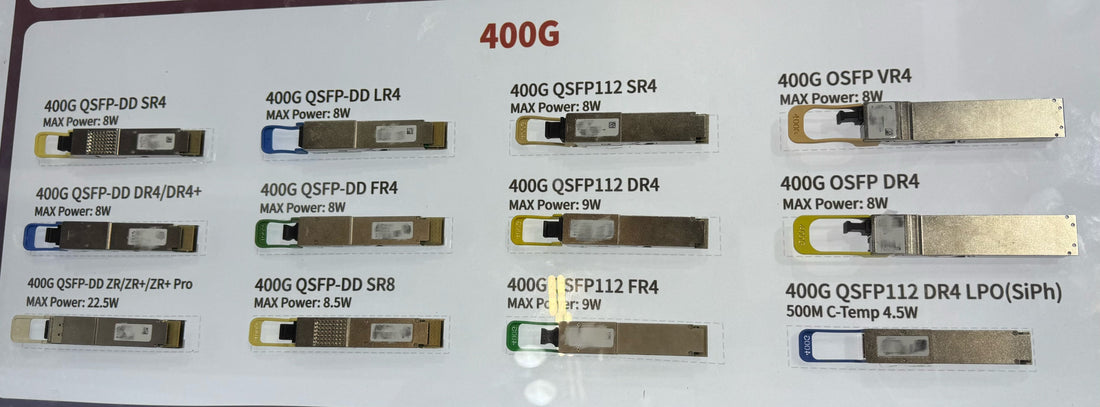
🔍 Article: Understanding the Full 400G Optical Module Suite & Their Use Cases
OptechTWShare
🔍 Article: Understanding the Full 400G Optical Module Suite & Their Use Cases
Introduction
With increasing demand for higher bandwidth, lower latency, and efficient data center interconnects, 400G optical modules have become essential. Vendors and infrastructure builders now have many options—QSFP‑DD, OSFP, QSFP112 form factors; SR, LR, DR, FR, ZR reach categories; and even breakout and VR types. Understanding what each module does, where it's best applied, and how to choose between them is key to future‑proof network design.

1. Key Types & What They Mean
Here are the definitions and differences among the types you listed:
| Module Standard | Reach / Fiber Type | Connector Type | Typical Use‑Case / Advantages |
|---|---|---|---|
| QSFP‑DD SR4 | Short reach (multimode fiber, OM4 / OM5), ~100 m or less depending on fiber | MPO‑12 | Intra‑rack / Top‑of‑rack / High bandwidth short links. |
| QSFP‑DD LR4 | Longer reach (single‑mode fiber), often several km (2‑10 km) | Duplex LC or similar | Between racks across rooms or buildings; campus links. |
| QSFP112 SR4 / VR4 | Higher density variants, sometimes same reach as SR4 but with more lanes or different form factor | MPO or other high‑density connectors | In setups demanding more density or infiniBand environments. |
| QSFP‑DD DR4 / DR4+ | “DR” stands for “Data Center Reach” — single‑mode fiber, often ~500 m to 2 km depending on module | MPO‑12 | For data center spine‑to‑leaf or leaf‑to‑leaf across longer distances where latency matters. |
| QSFP‑DD FR4 | Fixed Reach, usually 2 km or so, single‑mode | Duplex LC or CS‑style | When you need moderate reach without the cost/power of LR/ZR. |
| QSFP‑DD ZR / ZR+ | Very long‑haul, coherent optics usually, tens of kilometers (often >10–80 km) | Duplex LC, often supports DWDM | For inter‑data center links, metro, or campus wide links where optical loss is significant. |
| SR8 / SFP112 FR4 etc. | Variants/breakouts (e.g. more lanes, more fiber, etc.) | Multiplexed connectors (MPO etc.) | Used when you need flexibility: break into smaller ports; support multi‑lane traffic; or use older fiber infrastructure. |
2. Applications & Scenarios
Here are where different 400G module types tend to shine:
-
Intra‑Rack & Top‑of‑Rack Interconnects: SR4 / SR8 / VR4 options are great for connecting servers, switches within same rack or adjacent racks due to low cost, low latency, high density.
-
Leaf‑to‑Spine / Spine‑to‑Spine in Data Center: DR4, FR4, LR4 types when switching or aggregation across rooms / rows of racks.
-
Data Center Interconnect (DCI) / Metro / Campus Links: ZR / ZR+ modules enable much longer fiber paths, often coherent optics, for connecting distant data centers, or large campuses.
-
Breakout and Mixed Environments: Modules supporting breakout (e.g. 400G → 4×100G) are useful when some parts of the network still use 100G or NICs of lower speed.
3. Key Performance & Design Considerations
When selecting among these:
-
Optical Loss and Fiber Type: Multimode (MMF) vs Single‑mode (SMF). SR variants use MMF; LR, DR, ZR use SMF.
-
Connector Type: MPO‑12, MPO‑16, duplex LC, etc. This affects cable management, insertion loss.
-
Lane Count and Modulation Format: E.g., 8×50G PAM4 lanes for SR4; or DR4 uses 4×100G PAM4. Impacts cost, power, complexity. qsfptek.com+2Cisco+2
-
Power Consumption & Heat: Longer reach modules or coherent optics use more power and generate more heat; need to ensure switch / host has adequate cooling.
-
Standards / Protocol Support: IEEE 802.3bs, IEEE 802.3cu, MSA agreements (QSFP‑DD, OSFP, QSFP112) for interoperability.
-
Backward Compatibility / Breakout Usability: Some modules allow splitting into lower‑speed lanes (e.g. 400G → 4x100G) which helps transition periods.
4. How to Choose: Matching Use‑Case to Module
Here’s a simplified decision matrix:
| Need | Use This Module Type |
|---|---|
| Short budget‑sensitive links inside rack | SR4 / SR8 |
| Moderate reach (between racks or across rooms) | DR4 / FR4 |
| Long reach / campus / data center interconnect | LR4 / ZR / coherent optics |
| Mix of high and lower‑speed clients / legacy NICs | Breakout‑capable modules (SR4, DR4 etc.) |
| High port density / switch‑space constrained | OSFP / QSFP112 / high density versions |
5. Why 400G Now Matters
-
Data growth (AI, Big Data, ML) pushing for higher bandwidth.
-
Cloud infrastructure needs aggregating huge I/O per server / NIC.
-
Reduced cost per bit with modul‑lane economies.
-
Future proofing: buying 400G now ensures space for scaling without doubling deployment efforts.
✅ Conclusion
The 400G module ecosystem provides many form factors, reach categories, and breakout options to handle a wide variety of network requirements. For customers, selecting the right module is about matching physical layout (rack, room, building), fiber infrastructure, latency & power budgets, and growth plans.
